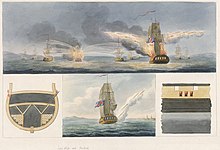HMS Galgo (1801)
She was refitted as a rocket ship in 1809, the Royal Navy's (and almost certainly the world's) first, and served as such but without distinction in the unsuccessful Walcheren Campaign.
In August, Hawkins came into the Downs from Ostend and reported to Admiral Lord Nelson that the number of boats there and their size was such that they did not pose any threat of a French invasion.
[6] Four months later, on 17 March 1803, Galgo came into Plymouth having lost her foremast in a violent gale of wind in Mount's Bay a few days earlier.
[7] By 30 March Galgo had a new mast and she sailed between St Nicholas's Island and Cornwall before anchoring in Cawsand Bay.
[9] In Spring 1804, Galgo joined Sir Sidney Smith's squadron off Helvoet, Flushing, and Ostende.
In May 1804, Galgo and Inspector cooperated in an unsuccessful attempt to cutout the pram Ville d'Anvers from Ostend.
Congreve had Galgo fitted with 21 scuttles (angled tubes) on her between deck, firing out through broadside ports.
On 13 August she was part of a squadron under Sir Home Riggs Popham that pushed up the West Scheld, but saw no action.
